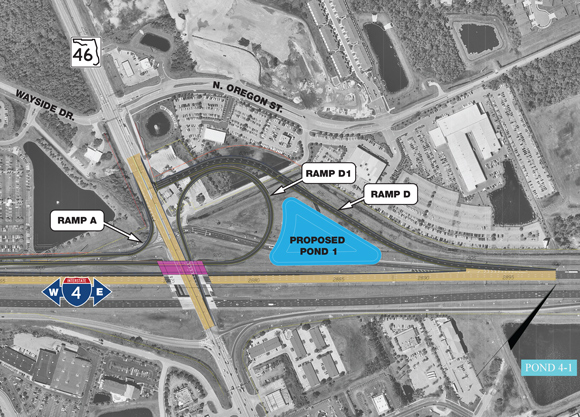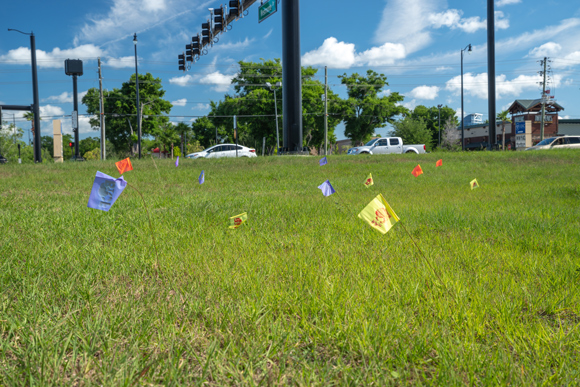FDOT Designing Additional Improvements for I-4 and S.R. 46 Interchange

|
| FDOT completed multiple improvements to the I-4 and S.R. 46 interchange in 2013. |
| |
Current design plans to upgrade the Interstate 4 (I-4) and State Road (S.R.) 46 interchange are comparatively minor compared to its overhaul years ago.
In 2013, the Florida Department of Transportation (FDOT) completed a $25.9 million project to boost safety and efficiency at the interchange. When the improvements were finished, motorists noticed a big difference in ease of travel.
The centerpiece of the project was a new loop entrance ramp from westbound S.R. 46 to westbound I-4. Instead of bringing motorists immediately onto I-4, the ramp first directs traffic onto a 3.5-mile, parallel roadway. This secondary road, called a collector-distributor, enhances safety by becoming the place where vehicles can change lanes for exit and entrance ramps at slower speeds, thus relocating the weaving movements from the more crowded travel lanes of the main interstate. It also enables westbound drivers to access S.R. 417 and County Road 46A without merging onto the I-4 mainline.
The project brought other enhancements, too. For example, reconfiguration of the westbound off and on ramps improved the safety and operation of S.R. 46 by separating the on-ramp traffic prior to the intersection with the off-ramp and S.R. 46.
Drivers have reaped the benefits of those changes for six years, and FDOT remains committed to keeping traffic moving safely through the area. This time, however, improvements currently in design are relatively minor. The interchange will gain two new left turn lanes: one on the eastbound I-4 off-ramp for traffic bound for westbound S.R. 46, and another on eastbound S.R. 46 for traffic entering the eastbound I-4 on-ramp. Plans also include a wider I-4 bridge over S.R. 46 to accommodate express lanes.
S.R. 46 is one of five interchanges in I-4 Beyond the Ultimate Segment 3, an 8.9-mile corridor that extends from 1 mile east of S.R. 434 to east of U.S. 17-92. The I-4 Beyond the Ultimate designs are improving safety and mobility through a combined 40 miles of I-4 in Volusia, Seminole, Orange, Osceola, and Polk counties. For efficiency, FDOT has organized I-4 Beyond the Ultimate into six design segments. For more information about ongoing design plans for Segment 3 in Seminole County, visit: i4Beyond.com/segment3.
|
|
FDOT Engineers Need to “Know What’s Below” Before Digging Begins

|
| Utility flag markers are important to maintain safe working environments for construction crews and anyone working on the marked site. |
| |
Just like homeowners landscaping or installing a fence want to avoid hitting utility lines, engineers of the Florida Department of Transportation (FDOT) have the huge and complex job of ensuring that the utility lines are not disturbed during highway construction.
But whether the digging equipment is a hand-held trowel or a powerful excavator, careful operators should follow advice promoted by the U.S. Department of Transportation to “Know What’s Below.”
And that’s especially crucial when dealing with 40 miles of public right-of-way along Interstate 4 (I-4) in Central Florida – the area to be transformed by I-4 Beyond the Ultimate. During development of concept and design plans for I-4 Beyond the Ultimate, the FDOT District Five utility office commissioned engineering studies to identify locations and verify owners of existing and proposed utilities – power, water, sewer, fuel, and communications lines – in and around each of the six design segments. Utility owners were provided design plans of proposed improvements to I-4 and asked to mark locations of their utilities to help FDOT identify lines requiring relocation.
Summaries of each utility company’s facilities and potential conflicts were included in Utility Impact Reports submitted to FDOT in 2016.
The Utility Impact Reports for all of the I-4 Beyond the Ultimate design segments are available at i4beyond.com/pde.
|
|
April is National Safe Digging Month
The Florida Department of Transportation (FDOT) reminds residents that April is National Safe Digging Month.
Homeowners should take the following steps when planning a digging project this spring:
- Always call 811 a few days before digging, regardless of the depth or familiarity with the property.
- Plan ahead. Call on Monday or Tuesday for work planned for an upcoming weekend, providing ample time for the approximate location of lines to be marked.
- Confirm that all lines have been marked.
- Consider moving the location of your project if it is near utility line markings.
- If a contractor has been hired, confirm that the contractor has called 811. Don’t allow work to begin if the lines aren’t marked.
- Visit www.call811.com for complete info.
A recent national survey revealed that 42% of homeowners who plan to dig this year for projects like landscaping; installing a fence or mailbox; or building a deck, pond, or patio; and other DIY projects, will put themselves and their communities at risk by not calling 811 a few days beforehand to learn the approximate location of underground utilities.
Serious injuries, service disruptions, and costly repairs can result when gas, electric, communications, water, and sewer lines are damaged.
|
|
|